PANCHA BHOOTAS OR THE FIVE ELEMENTS
Contents
. Introduction
. Karmendriyas and Jnanendriyas
. The five elements and Vishnu Iconography
. The five elements and seven chakras
. The five elements and the Doshas or intrinsic tendencies
. Taste and the five elements
. The three vital essences and the five elements
. Vastu and the five elements
. The Sri Chakra and the five elements
. Buddhist philosophy on elements
. Chinese philosophy on elements
. Greek philosophy on elements
. The Elements and Western Astrology
. Conclusion
Introduction
The Divine reveals the glories of this universe to mankind through Prakriti or Nature. No one can comprehend nature. It presides over the destinies of all creatures. Continual change is the very nature of creation. It is impermanent and immutable. The Creator is the only Unchanging eternal entity amongst this changing world.
The entire cosmic creation begins from the point of the Pancha Bhutas or the 5 elements. They are Earth or Prithvi, Water or Jal, Fire or Agni, Air or Vayu, Ether or Akash. These five elements contain five characteristics. They account for the five faculties of Shabda(sound),Sparsha(touch),Roopa(sight),Rasa(taste),Gandha (smell).Thus every individual has these distinct five faculties as each of these faculties has emanated from one particular element.
Akash or Ether is the first element and accounts for the emergence of the organ of hearing-the ear and is represented by sound. It represents the space in which everything takes place
The second element is Vayu or air and the skin is the product of the principle represented by touch. It represents the gaseous state of matter and is responsible for the respiratory system.
The third element is Agni or fire and the eye is the organ representing sight. It represents form without substance and is responsible for digestion and perception.
The fourth element is Jal or water and is represented by the organ tongue which is used for the dual function of taste and speech. It represents the liquid state of matter and is responsible for fluid metabolism in the body. Blood, lymph and other fluids are considered as water elements.
The fifth element is Prithvi or earth and the nose is the organ representing smell. It represents the solid state of matter and is responsible for the physical constitution of the body. Bones, tissues and teeth are considered as earth elements.
Earth or Akash is the most subtle element, each element in turn is used to create the next element, each less subtle than the next. The basest element earth can be perceived by all five senses sight, hearing, smell, taste and touch. The next higher element water has no smell but can be heard, felt, seen and tasted. Next comes fire which can be heard, felt and seen. After that comes air which can be heard and felt. Last comes Akash which can only be heard.

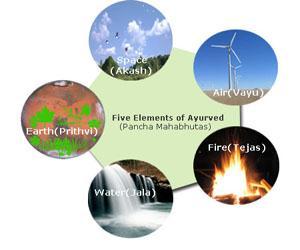
Karmendriyas and Jnanendriyas
All the external sense organs which enable us to interact with the material objects of the world like the eyes, ears, nose, tongue and skin are called Jnanendriyas or organs of cognition and the internal organs of action that facilitates our sensory contact with the outer world like Speech and the mouth, Grasping and the hands, Walking and the feet, Procreation and the reproductive organs, Elimination and the Anus are called Karmendriyas.
The Karmendriyas perform acts in the world and receive knowledge while the Jnanendriyas discriminate the good and the bad and through the mind, offer them to the Atma. Thus these organs which are connected with Prakrithi can attain the Atma only through the mind. The combined operations of all these sense organs accounts for the human personality. The ten organs, the five elements and the mind constitute the Shodasha Kalas or the Sixteen Kalas. Every individual has these sixteen kalas but only the Divine is considered to have all these sixteen kalas in full perfection.
- Smell is associated with Earth element.
Particles of matter or the solid forms of earth impinge on the sensitive cells within the nose, the changes arising there from is recognized as smell by the corresponding brain centre which receives the sensory impulses from the olfactory region of the nose through the nerves.
- Taste is associated with water element
The liquid forms of matter is characterised by fluidity. The sense of taste is imparted by the solution of any substance on the tongue. The changes are induced in the taste buds of the tongue and are conveyed to the corresponding brain centre through the sensory nerves.
- Shapes and forms are associated with fire element.
Light energy in the visible spectrum is received and recognized by the eye. Thus this element represents that entity which provides definition to any material object. The perception of rupa or form is associated with this element.
- Touch is associated with air element.
Here it represents electro magnetic energy whose distinguishing feature is movement. When energy impinges on the skin as heat or electrical sensation, the impulses are carried through the sensory nerves to the corresponding centre in the brain. Touch is essential for this knowledge and the quality is attributed to vayu or energy in motion.
- Sound with ether element
There is no sound propagation through a vacuum. Sound requires a medium. Speech is conveyed to the ears through air. Vibration of successive particles of a medium is propagated as a sound wave. These impulses are then carried by the auditory nerves to the relevant centre in the brain which interprets it as sound. Thus akash or space or ether is considered to be a conveyor of sound.
Thus the five great elements represent the universe of matter-energy.
Any imbalance in these five elements creates disharmony in the universe like natural disasters and disease in the human body.
In the Bhagvad Gita, Krushn says, ’’The five elements along with the mind, intellect and ego sense constitute the lower nature. Know my higher nature which is pure consciousness’’.
Just as the universe is made up of five elements, the mind is also made up of five elements in a subtle form. Depending on which of the elements dominate, the individual experiences different moods and sensations.
Some examples are-
- Feeling of heaviness, total comfort or discomfort- Earth element is dominant
- Feeling of oneness, togetherness, floating or flowing feeling- Water element is dominant.
- Feeling of wanting to keep moving, keep running away-Air element is dominant.
- Feeling of passion, fired by ambition-Fire element is dominant
- Feeling expansive and light-Space element is dominant.
To create a balancing effect of these five elements on the body and mind, Yoga, pranayama etc are the techniques generally adopted by men.
Thus, it can be said that these five elements are derivations and expressions of a Unifying Creative Principle which is unmanifested and one. They have to be understood both in a material sense and a subtle sense. One has to delve deep and extract the inner meaning within each one.
By Earth, it is not merely the physical terrain or the human body but the strength of mind, steadfastness, determination and uninterrupted advancement towards the goal.
By water, it implies the cohesive reality which flows into and holds all beings together and links each other to the Ultimate Reality.
By fire it does not only mean the Universal energy that radiates heat and light but the inner fire that removes the cloak of ignorance and destroys all our doubts and allows the Truth to shine despite all obstacles.
By air, it not only implies the rarified force that exists in the universe but the energy that allows digestion, removes wastes and ensures circulation in the human body. It regulates thoughts in our mind through steady breathing.
By space it means everything that encompasses us, the mind which is the vessel to receive all impressions, the heart which accepts love.
For eg. In a single living cell, the structure of the cell is the earth element, the liquid or cytoplasm within the cell membrane is the water element, the metabolic processes regulating the cell is the fire element, the gases regulating the functioning of the cell is the air element and the space occupied by the cell denotes the space element.
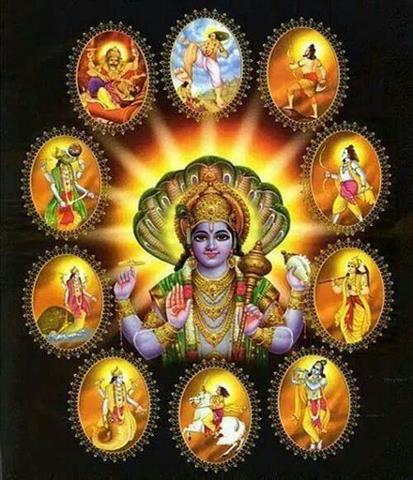
The five elements and Vishnu iconography
There is a curious link between these five elements and the Vishnu image portrayed in Vaishnavite temples. The Vishnu Puran and Garuda Puran refer to five forms of Vishnu-Vasudeva, Sankarshana, Pradyumna, Aniruddha, Narayana. The meanings of these names indicate a connection to the five elements.
1. Vasudeva means ‘’that in which all things abide ’’indicating the element ether.
2. Sankarshana means ‘complete attraction’ or squeezing together indicating the element of Aeriality.
3. Pradyumna means ‘the radiant one’ indicating the element fire.
4. Anirudha means ‘without obstacles’ indicating liquidity or water.
5. Narayana means ‘son of man, path of man, eternal man’ indicating the element earth.
The Five elements and Seven chakras
The five elements from which all creation is manifest are accessible through ‘Chakras’ located in the spinal area. The Chakras are energy centres in the astral body corresponding to five locations in the spinal region and two in the area of the brain. Each chakra is endowed with the capacity to awaken certain powerful features.
- Muladhara chakra or Root Chakra-it represents stability and support. It indicates Earth element.
- Swadishthan or Sacral chakra- it represents joy and general sense of well being. It indicates Water element
- Manipura or Solar plexus chakra- it represents power and wisdom. It indicates Fire element.
- Anahata or heart chakra-It represents love, forgiveness, compassion to all. It indicates Air element.
- Vishuddha or throat chakra-It represents faith in ourselves, trust in others, creativity. It indicates ether element.
- Ajna or brow chakra- It represents knowledge, dignity, intuition. It indicates ether element.
- Sahasrara or crown chakra- It represents perfect balance, oneness with the universe. It indicates ether element.
The Five elements and the Doshas or intrinsic tendencies
The five mahabhutas are present in the body and are represented in the form of doshas. There are three doshas vata, pitha and kapha meaning air, bile and phlegm. Doshas are very important as they form the basis for the maintenance of sound health, diagnosis and treatment of diseases. Each person is born with a particular proportion of these three doshas. Each dosha has specific organs or locations in which it is primarily found. If the balance between the doshas is disturbed, disharmony is created internally as well as with the external energy system and this results in disease.
Vata is composed of the elements space and air, pitha of fire and water, kapha of earth and water. Thus the physical and mental qualities of each dosha will reflect the elemental qualities of the element it is related to. Thus Vata types are thin, fast moving and quick thinking. Pitha types have an oily skin and fiery personality and Kapha types have solid body frames and calm temperament.
Since the doshas are the combination of the elements and the elements are the building blocks of everything in the universe, the forces of doshas are present in everything in the universe. We can see these primal energies in our bodily functions, in the seasons of the year and the times of day. Unlike the elements, the presence of doshas can be observed as we can see the effects of their presence. Vata is the force of wear and tear that results in destruction or degeneration of the universe, Pitha maintains the creation and kapha is considered to be the creative force.
Fire, Air and Ether elements are light and tend to move upward. They move the energies of the doshas upwards producing lightness. Earth and water elements are heavy and move downwards producing heaviness in the body.
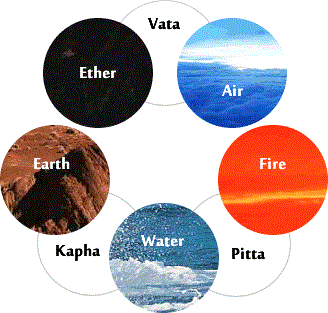
Taste and the five elements
There are six tastes in the human body. They are sweet, sour, salty, pungent, bitter and astringent.
Tastes act upon the doshas and either increase or decrease the quality of the doshas. Given below is the particular type of taste and it’s corresponding predominant element.
1. Sweet- earth and water.
2. Sour-earth and fire
3. salty-water and fire
4. pungent-air and fire
5. bitter-air and ether
6. astringent-air and earth
The three vital essences and the five elements
The three doshas have subtle counterparts Prana, Ojas and Tejas. Prana(vata dosha) relates to the air element. Tejas(pitha dosha) relates to the fire element. Ojas(kapha dosha) relates to the water element. They are the positive essences of the three doshas and they control the body-mind functions. They keep us free from diseases and promote positive health.
Prana-It is the subtle energy behind all mind-body functions and the primal life force. It is responsible for the coordination of breath, senses and mind. At the deepest levels of consciousness it governs the development of the higher states of consciousness.
The five prana vayus are apana, vyana, samana, prana, udana.
Apana is located in the lower extremities and is responsible for excretion. It is related to the earth element.
Vyana is located all over the body. It enables circulation and is related to the water element.
Samana is located in the navel. It regulates metabolism and digestion and is related to the fire element.
Prana is located in the chest and lungs and is responsible for breathing. It is related to the air element.
Udana is located in the throat and enables speech and communication. It is related to the ether element.
Tejas-It is the subtle energy of fire, the inner radiance through which we digest impressions and thoughts. It enables the mind to perceive and judge correctly. At the deepest levels of consciousness it gives spiritual insight.
Ojas –It is the subtle energy of water, fed through sensory impressions of taste and smell. It provides stability and endurance. At the deepest levels of consciousness it is the material power from which the soul produces the energy bodies and provides nourishment to higher states of consciousness.
Vastu and the five elements
Vastu or the Indian Feng shui is the ancient Vedic tradition of combining architecture and land development with the energies of the five elements and the cardinal directions. Living in accordance with Vastu is said to solve most of life’s problems. The balance or imbalance among the elements determine the conditions of one’s living space.
Water-Water is associated with conception of new ideas, thoughts, healing energy, restoration of health etc. Water dominates the North direction in buildings. When water is in a balanced state in a building, it induces a spiritual and philosophical attitude to life. For eg-placement of water sources like wells, water tanks etc in the North direction gives maximum advantage.
Air-Air represents growth and is associated with movement, joy and happiness. Air dominates the East direction. When air is in a balanced state, it induces courage and perseverance to achieve your goals. For eg-placement of doors, windows etc should be in the East or North east direction to get maximum benefit
Fire-Fire is the driving force behind all life processes and South is the direction of fire. When it is in a balanced state, it induces power, confidence, fame recognition and money. For eg-geysers, fireplace and kitchen in the South/South east direction would provide maximum benefits.
Earth-Earth represents stability and balance and dominates Centre and Diagonal directions. When it is in a balanced state, it induces stability and a feeling of peace and harmony. for eg-Since earth is connected to all five senses of the human body, sleeping with the head towards the south helps us to draw maximum positive energy from the cosmos.
Space-Space represents expansion and enhancement and dominates the Western direction. When it is in a balanced state, it induces knowledge and awareness to understand new and creative ideas. For eg- the Brahmasthan or the central portion should be built in such a way that light enters its centre and it should always be kept open.
Since these five elements are related to our five senses taste, smell, hear, touch and sight the aim of Vastu Shastra is to enable a perfect construction and to correct the internal and external imbalances and ensure a peaceful and stress free life.
The Sri Chakra and the five elements
The Sri Chakra is considered to be the abode of the Divine Mother or the Goddess Lalitambika. The five downward pointing triangles in the Sri Chakra represent the Shakti principle and from them arise the five elements or the Pancha Mahabhutas indicating creation. The four upward pointing triangles represent the Shiva principle indicating dissolution. The union of the two causes the chakra of creation to evolve. Harmony in creation implies balance in the elements.
The Taittiriya Upanishad states that all creation is made up of these five elements which came from the Supreme Being. From the self (atma) space came into being, from space came air, from air came fire, from fire water, from water earth, from earth man and man has within himself the self (atma).
Thus, it is considered that the energy of the five elements is what awakens a person’s divine channels. They are considered the five pillars of creation. When the spiritual energy of an individual is awakened, it awakens the energy of the five elements. Once he is aligned with the energy of the elements through advanced techniques , miracles begin to happen. He can heal others by connecting directly to the cosmic energy. This brings the highest peace, opens the heart, increases willpower and mental clarity and creates positive vibrations. Wisdom grows and life becomes more successful.
The Lord is the inner energy hidden in the five elements as the Creator. Understanding this inner energy and purifying it washes out negative illusions and creates a balancing effect in the five elements. This leads to ‘Sthithaprajna’ or a state of equilibrium.
Buddhist Philosophy on elements
In Buddhism, the first four elements are regarded as the base and the four properties associated are
1) water-cohesion or fluidity,
2) earth-solidity or inertia,
3) air-expansion or vibration,
4) fire-heat or energy content
In Buddhism the four elements are a basis for understanding and for liberating oneself from suffering.
Earth element includes hair, nails, teeth, skin, flesh, bones and other physical or solid material of the body
Water element includes bile, blood, sweat, urine and other liquid elements of the body.
Air element includes internal air elements like respiratory system (breathing),intestinal system(wind in the bowels and other regions) of the body.
Fire element includes internal fire mechanisms that provide digestion, warmth and other metabolic processes.
Two more elements ie the space element and the consciousness element are sometimes referred to in certain Buddhist texts.
According to Buddhist philosophy the four elements give rise to the five aggregates which are the ultimate basis of suffering which helps man to seek the four basic truths as expounded by Buddha.
Four elements--- Form---Five aggregates---Suffering---Four noble truths
Aggregates-They are the five aspects that constitute the sentient being. They are form or matter, sensation or feeling, perception or cognition, mental formations or impulses and consciousness or discernment. The aggregates progress from form to feeling to perception to mental formations to consciousness.
Buddha is often compared to a great physician and his teachings are compared to medicine.
The four Noble truths-
1. The truth of suffering-identifying the illness and the nature of the illness (the diagnosis)
2. The truth of the origin of suffering-identifying the causes of the illness (the etiology)
3. The truth of cessation of suffering-identifying a cure for the illness (the prognosis)
4. The truth of the path leading to cessation of suffering- recommending treatment for the illness to bring about a cure (the prescription)
It is said that the brilliance of Buddha’s philosophy was that it had as its aim the reliving of suffering hence no speculation, no belief about God, no leap of faith, nothing metaphysical was needed. It could be practiced by anyone, anywhere as the teaching is universal and experienced by all and its primary goal is the “Suffering and the end of suffering”
Thus to understand Buddha’s teachings, it is necessary to have a deep insight to the elements and progress upto the goal of life which is the end of suffering and ultimately attain Divine bliss.
Chinese philosophy on elements
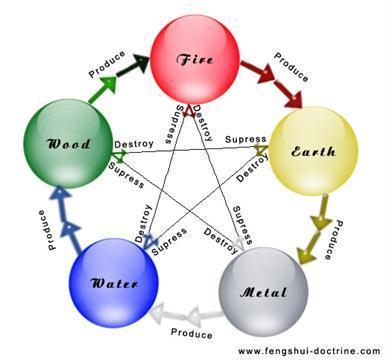
In this they have five elements Fire, earth, metal, water and wood. These elements are seen as ever changing and moving. There are two cycles of balance, one creation and the other destruction.
Creation(generating)

Destruction(overcoming)

Greek Philosophy on elements
According to Greek philosophy the four elements are fire, earth, air and water. The Macrocosmic manifestations of the elements are the land, the sea, the sky and the sun. They are connected with the sublunary spheres Heaven, Earth, Abyss(the subterranean water) and Tartaros (the subterranean fire).The microcosmic manifestations are the components of the human psyche-mental, astral, etheric and physical bodies. The elements also represent the stages in various processes of growth and transformation.
Earth is considered to be cool and dry, passive and rigid and therefore psychologically predominant in persons who focus extensively on physical reality and exhibit qualities of perseverance and realism.
Water is considered to be fluid and associated with union and transformation and therefore psychologically predominant in persons who tend to be flexible, flowing and inclined towards deep feeling.
Fire is considered to be hot and fiery and is associated with metabolic processes and therefore psychologically associated with the qualities of energy, assertiveness and passion.
Air is considered to be moist and warm and associated with differentiation and flexibility and therefore psychologically associated with the qualities of discrimination, critical thinking and knowledge.
In Greek philosophy Air has an essential role as the Spirit which unites the Mind with the Body. Air is important as a mediating element .It is considered the most spiritual element for it corresponds to the Spirit Breath and the Spirited Soul which unite the mind and body. It also constitutes the Cosmic Breath which unites our individual soul to the Universal World Soul.
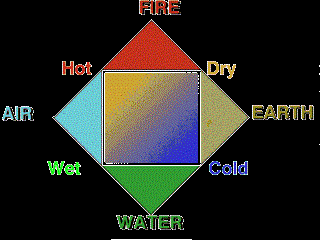
The Elements and Western Astrology
Western Astrology deals with four elements earth, air, water and fire. Each element is associated with subtle qualities and the birth chart of each individual gives a mix of these elements. Each element is assigned three signs called Zodiac signs (signs which are assigned according to the month of birth) The signs of a grouping exhibit certain similar characteristics.
Fire signs- inspired, outgoing, active-deals with the spirit. They are Aries, Leo and Sagittarius
Fire creates warmth and passion. Too much fire means taking unnecessary risks and surging forward without consideration for others. Too little fire means there’s no joy in life, things seem repetitive, mundane and superficial. The ways to create a balance are to be enthusiastic about ideas but follow them diligently one at a time, feel joyful of life etc.
Air Signs- ideas, concepts-deals with the mind. They are Libra, Gemini and Aquarius.
Air is about breath, thoughts and currents. Too much air leads to too many thoughts, highly strung and too much dissipation of energy through excessive talk, work etc. Too little air implies not being objective, becoming easily bored and apathetic. The ways to create an air balance is to cultivate healthy ways to burn off excess energy and keep the mind calm.
Water signs- imaginative, introverted-deals with the emotions. They are Capricorn, Taurus and Virgo.
Water purifies and cleanses, too much water means unable to see with detachment and heavy with emotional baggage. Too little water implies dry, brittle, harsh with ourselves and others unable to find consolation. The ways to create a water balance are physically connecting oneself to more water spots, eating more fruits and vegetables with added water content etc.
Earth Signs-practical, grounded-deals with the body. They are Cancer, Scorpio and Pisces.
Earth connects us to bodily pleasures like taste, touch, smell, sight and hearing. Too much earth means too wordly, sensual and attached. Too less earth means unable to be grounded, to grasp reality and to think concretely. The ways to create an earth balance is to spend more time with nature, give adequate time to bodily needs etc.
Thus the key to a harmonious life is correcting all the imbalances in these elements in us and leading an enriched and fulfilling life.
Tarot cards-In this a deck of cards with symbolic imagery is used to serve as a means to stimulate our intuition and help us to tap into the unconscious parts of ourselves. The deck is divided into four separate suits Wands, Cups, Swords and Pentacles and each suit represents a particular energy and is associated to an element. Understanding the characteristics of each suit and their correlating element deepens one’s understanding of the various Tarot card meanings.
Wands-Element is fire and signifies action, movement, fertility etc.
Cups-Element is Air and signifies ideas, concepts, abstract thinking etc.
Swords-Element is Water and signifies emotions, love, compassion etc.
Pentacles-Element is Earth and signifies physical body, possessions etc.
Conclusion
Thus it can be seen that the elements in creation form the fundamental unit to the secret of the entire Universe and a deep understanding of the elements ,its significance and its subtle effects is the key to leading an Ideal Life of Peace, Prosperity and Eternal Happiness.
1.wikipedia.com
2.indiatemple.blogspot
3.mahavasthu.com
4.shaivashakti.com
5.webwinds.com
6.astrology.about.com
7.tarotreadingpsychic.com
8.buddhanet.net
9.ealmanac.com
10.hometrainingtools.com
